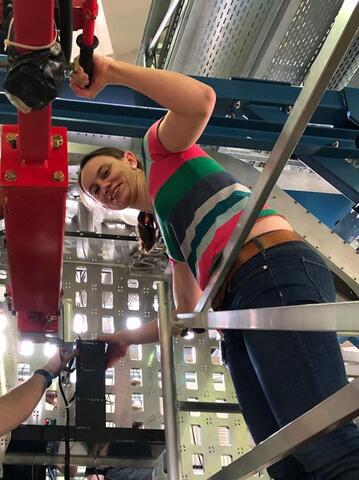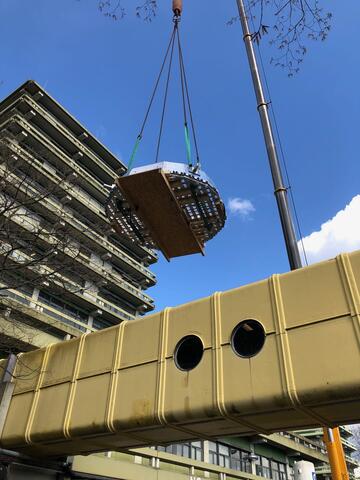Workshop „Physics Opportunities with Proton Beams at SIS100” was held in Wuppertal
PANDA meetings
04/03-08/03 2024 CM 24/1 in Münster
24/06-28/06 2024 CM 24/2 at GSI
25/06-26/06 2024 FEE/DAQ Workshop
04/11-06/11 2024 CM 24/3 at GSI
05/03-07/03 2025 WS at GSI
16/06-20/06 2025 CM 25 in Uppsala
Studies of SiPM photosensors for time-of-flight detectors within PANDA at FAIR
Lukas Gruber
TH-PHD-2014-004.pdf
(35.19 MB)
The PANDA experiment at FAIR is a planned particle physics experiment dedicated to strong interaction studies using proton-antiproton annihilations. The PANDA time-of-flight (TOF) system is foreseen as a Scintillator Tile (SciTil) Hodoscope, which will deliver valuable input for event timing and particle identification. The proposed detector is based on small plastic scintillator tiles with a size of about 30 x 30 x 5 mm³, which are read-out with directly attached Silicon Photomultipliers (SiPMs). The whole system is composed of 5760 scintillator tiles and twice the number of photodetectors, covering an area of about 5.2 m² in total. The requirements for the detector are a time resolution in the order of 100 ps sigma and a minimum use of material due to the limited space inside the PANDA spectrometer.
SiPMs are extremely versatile photodetectors which tend to successively replace the ordinary vacuum Photomultiplier Tubes (PMTs) in many of the photosensing demands ranging from particle physics to medical imaging. Due to many advantages like good time resolution, high photon detection efficiency (PDE), compactness, low operating voltage, radiation hardness, low cost and, in contrast to PMTs, insensitivity to magnetic fields, SiPMs are well suited for applications in high energy physics like PANDA. Recently, Philips invented the first fully digital SiPM (DPC), which allows to exploit the quasi digital nature of single photon detection. The analog and digital SiPM, respectively, are the main detector technologies used within this work.
This thesis describes a detailed study of SiPM properties in order to characterize the new devices and get a profound understanding of their functionality. The characterization studies have been carried out using various experimental setups employing pulsed pico- and femtosecond lasers. With regard to applications in high energy physics experiments, e.g. the PANDA TOF system, parameters like SiPM gain, dark count rate, time resolution, dynamic range and recovery time as well as their temperature dependence have been investigated. In this context, the time resolution of conventional analog SiPMs and of the digital SiPM is discussed. Using SiPMs with some technology against cross-talk and after-pulses, e.g. trenches between pixels, led to larger operating ranges and better overall performance. The presented results show that SiPMs are well suited for usage in the SciTil system.
For the further development of a scintillator based detector suitable for PANDA, a detailed optimization study including parameters like the scintillator material and size, the photodetector position, type and quantity as well as the electronics threshold has been carried out. The aim was to find out how the individual parameters contribute to the time resolution of a scintillator based TOF detector and to finally achieve the goal of a time resolution below 100 ps sigma. In this context, also the statistics of photon emission as well as the photon propagation in a plastic scintillator are studied. Comparing different types of plastic scintillators showed that the scintillation time constants as well as the intrinsic light yield influence the time resolution. In this context, it was shown that scintillators for highest time resolution should provide short rise- and decay times and highest light output, as expected from theory. The geometry of the scintillator affects the time resolution as it defines the impact of photon propagation. Increasing the scintillator size led to reduced time resolution. In a basic measurement setup using a Sr90 source and an EJ-228 plastic scintillator read-out with the Philips DPC, a time resolution of sigma = 62.3 ± 0.8 ps could be eventually achieved.
To finally proof the feasibility of reaching a time resolution of 100 ps sigma with the proposed scintillator tiles, a prototype SciTil detector based on the optimization studies has been developed and tested in a 2.7 GeV/c proton beam. Results of the beam test experiment at Forschungszentrum Jülich are presented. In course of the measurement, various commercially available SiPMs with 3 x 3 mm² sensitive area as well as the Philips DPC have been employed in combination with different types of fast plastic scintillators. The data analysis showed that energy deposit fluctuations and variations in the number of detected photons have a big influence on the time resolution due to the time slewing effect. It is shown that applying appropriate corrections leads to drastic improvement in time resolution and values well below 100 ps sigma can be achieved. Using two KETEK SiPMs (PM3360TS) attached to an EJ-232 plastic scintillator, a time resolution of sigma = 82.5 ± 1.7 ps was obtained. Employing the Philips DPC, a value of sigma = 35.4 ± 0.4 ps was found.
In order to further optimize the scintillation counters for the SciTil system, a simulation tool for scintillator based detectors using Geant4 has been developed. The simulation aims to provide a deeper understanding of the physical processes and will help to push the time resolution towards the limits and finalize the detector layout. Preliminary results on the detected number of photons and time resolution of a scintillator tile read-out with two photodetectors show that the simulation can already reproduce the trend of experimental results. In this context, the simulation confirms that a scintillation detector aiming at highest time resolution should make use of multiple time stamps.
SiPMs are extremely versatile photodetectors which tend to successively replace the ordinary vacuum Photomultiplier Tubes (PMTs) in many of the photosensing demands ranging from particle physics to medical imaging. Due to many advantages like good time resolution, high photon detection efficiency (PDE), compactness, low operating voltage, radiation hardness, low cost and, in contrast to PMTs, insensitivity to magnetic fields, SiPMs are well suited for applications in high energy physics like PANDA. Recently, Philips invented the first fully digital SiPM (DPC), which allows to exploit the quasi digital nature of single photon detection. The analog and digital SiPM, respectively, are the main detector technologies used within this work.
This thesis describes a detailed study of SiPM properties in order to characterize the new devices and get a profound understanding of their functionality. The characterization studies have been carried out using various experimental setups employing pulsed pico- and femtosecond lasers. With regard to applications in high energy physics experiments, e.g. the PANDA TOF system, parameters like SiPM gain, dark count rate, time resolution, dynamic range and recovery time as well as their temperature dependence have been investigated. In this context, the time resolution of conventional analog SiPMs and of the digital SiPM is discussed. Using SiPMs with some technology against cross-talk and after-pulses, e.g. trenches between pixels, led to larger operating ranges and better overall performance. The presented results show that SiPMs are well suited for usage in the SciTil system.
For the further development of a scintillator based detector suitable for PANDA, a detailed optimization study including parameters like the scintillator material and size, the photodetector position, type and quantity as well as the electronics threshold has been carried out. The aim was to find out how the individual parameters contribute to the time resolution of a scintillator based TOF detector and to finally achieve the goal of a time resolution below 100 ps sigma. In this context, also the statistics of photon emission as well as the photon propagation in a plastic scintillator are studied. Comparing different types of plastic scintillators showed that the scintillation time constants as well as the intrinsic light yield influence the time resolution. In this context, it was shown that scintillators for highest time resolution should provide short rise- and decay times and highest light output, as expected from theory. The geometry of the scintillator affects the time resolution as it defines the impact of photon propagation. Increasing the scintillator size led to reduced time resolution. In a basic measurement setup using a Sr90 source and an EJ-228 plastic scintillator read-out with the Philips DPC, a time resolution of sigma = 62.3 ± 0.8 ps could be eventually achieved.
To finally proof the feasibility of reaching a time resolution of 100 ps sigma with the proposed scintillator tiles, a prototype SciTil detector based on the optimization studies has been developed and tested in a 2.7 GeV/c proton beam. Results of the beam test experiment at Forschungszentrum Jülich are presented. In course of the measurement, various commercially available SiPMs with 3 x 3 mm² sensitive area as well as the Philips DPC have been employed in combination with different types of fast plastic scintillators. The data analysis showed that energy deposit fluctuations and variations in the number of detected photons have a big influence on the time resolution due to the time slewing effect. It is shown that applying appropriate corrections leads to drastic improvement in time resolution and values well below 100 ps sigma can be achieved. Using two KETEK SiPMs (PM3360TS) attached to an EJ-232 plastic scintillator, a time resolution of sigma = 82.5 ± 1.7 ps was obtained. Employing the Philips DPC, a value of sigma = 35.4 ± 0.4 ps was found.
In order to further optimize the scintillation counters for the SciTil system, a simulation tool for scintillator based detectors using Geant4 has been developed. The simulation aims to provide a deeper understanding of the physical processes and will help to push the time resolution towards the limits and finalize the detector layout. Preliminary results on the detected number of photons and time resolution of a scintillator tile read-out with two photodetectors show that the simulation can already reproduce the trend of experimental results. In this context, the simulation confirms that a scintillation detector aiming at highest time resolution should make use of multiple time stamps.





